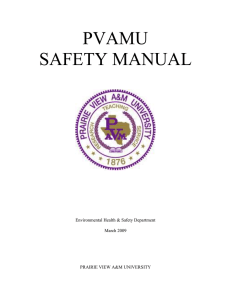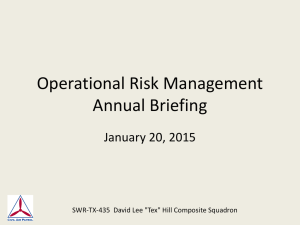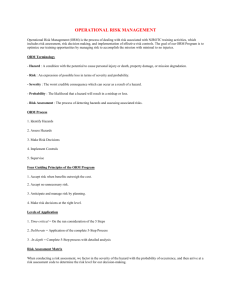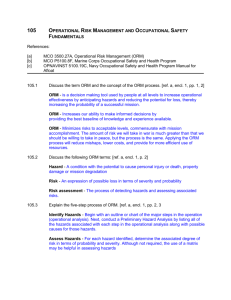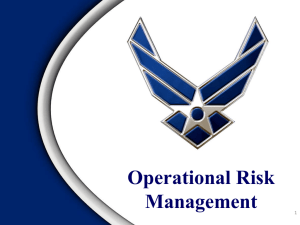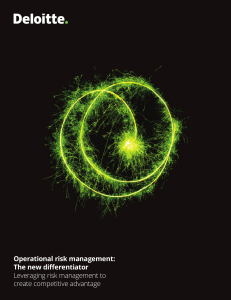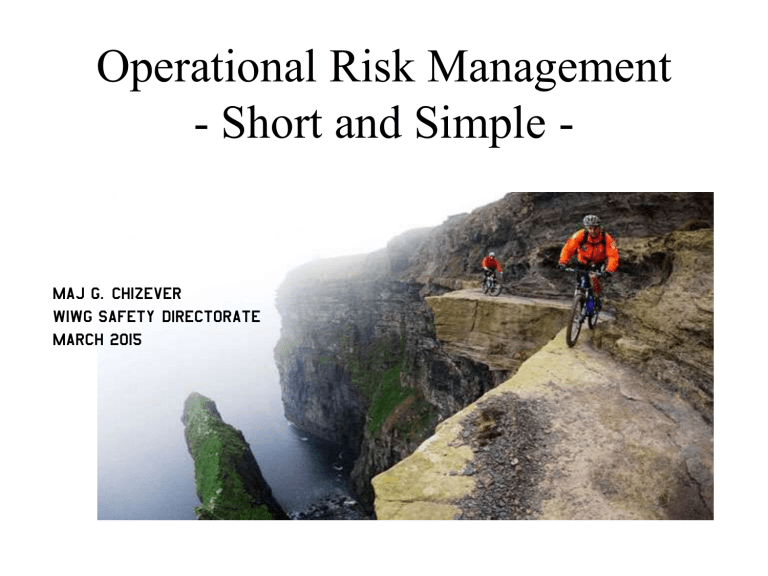
Operational Risk Management - Short and Simple - Maj G. Chizever WIWG Safety Directorate March 2015 Adapted from: • http://www.mcieast.marines.mil/Portals/33/Documents/Safety/OSH/ORM.ppt • CAP On-line Safety Education ORM Course Purpose of ORM • Purpose of ORM – enhancing hazard identification in the operational environment in order to eliminate risks or reduce them to an acceptable level • ORM follows a 5 step sequence, with 3 levels of application • Closed-loop process applicable to most operational and organizational situations and environments • Gradually being supplanted by broader concept of generalized Risk Management – – Evaluation of Risk/Benefit tradeoffs in all action contexts Benefits out-way the risk? Definitions • ORM • The process of dealing with risks associated with operations, which includes risk assessment, risk decision making and implementation of effective risk controls • A tool used to help participants make sound decisions in a logical manner in order to manage IDENTIFIED RISKS • Hazard • A condition with the potential to cause personal injury or death, property damage or mission degradation Definitions (cont.) • Probability • The likelihood that a hazard will materialize • RISK • Potential loss stemming from a hazard times the hazard’s probability and severity ----------------------------------------------------- • Red-Slice Unknowns – – The unknowns for which awareness is lacking not suspected or thought of during the risk assessment process • The Six Steps of the ORM Process 1. Identify the hazards 2. Assess the risks 3. Analyze the risk control measures 4. Make control decisions 5. Risk control implementation 6. Supervise and review Risk Assessment Matrix Risk Assessment Matrix Operations Planning Process Objectives Execute Plan Estimate the situation Identify Hazards Supervise Risk Management Process Implement Controls Access Risk of Each Hazard Make Risk Decisions Develop Controls Coarse of Action Development Coarse of Action Decision Brief Origin of ORM • 1978 Bob Firenze, a Navy civilian wrote an article for the Naval Safety Center’s Lifeline magazine identifying Risk Management and its benefits in industrial work place. • 1991 the Army began working ORM into briefs, schoolhouses and Operational Planning. Since then, ORM has become the Army’s primary risk reduction process to protect the force. Their goal Is “to make risk management a routine part of planning and executing operational missions”. Risk Comparison TRADITIONAL Random, Individual Dependent Common Sense Uninformed Decision Reactive ORM Systematic Methodical Informed Proactive •Human Error - an individual’s actions or performance is different than what is required and results in or contributes to an accident. •Material Failure/Malfunction - a fault in the equipment that keeps it from working as designed, therefore causing or contributing to an accident. •Environmental Conditions - any natural or manmade surroundings that negatively affect performance of individuals, equipment or materials and causes or contributes to an accident. Individual Failure - Personnel knows and is trained to standards but elects not to follow the standard (self-discipline). Leader Failure - Leader does not enforce known standard. Training Failure – Personnel not trained to known standard (insufficient, incorrect or no training on task). Standards Failure - Standards/procedures not clear or practical, or do not exist. Support Failure - Equipment/material improperly designed to meet performance standards. 4 Principles “ORM Golden Rules” 1. Accept risk when benefits outweigh the costs 2. Accept no unnecessary risk 3. Anticipate and manage risk by planning 4. Make risk decisions at the right level 3 Levels of Application • Time Critical or Ad Hoc • On the run consideration • Deliberate / Formal • Application of the 5 Step Strategy • Planned well in advance of activity • In-depth or Strategic • Complete the 5 Step Strategy with detailed analysis – time/resource intensive, for complex programs with hi “red slice” potential Benefits out-way the risk? •Engineering New Technology, design, substitute material •Education Collective/individual training •Administrative Establishing written programs, limiting exposure •Physical Barriers, PPE, road guards, warning signs •Operational Map exercises, rehearsals, pace of operations Monitor and Enforce controls Use evaluation techniques to look for new hazards Examine data/make adjust that are ineffective Evaluate effectiveness of controls and revise if necessary Evaluation Tools Spot Checks/Back Briefs Audits/Inspections Readiness Reports Licensing Rehearsals Certification Procedures Summary Enhances operational mission accomplishment Supports well-informed decision making to implement a Course of Action. Provides assessment tools to support operations. Improves decision making skills based on a systematic approach.. ONLINE SITES • Safety Division; http://hqinet001.hqmc.usmc.mil/sd/documents.htm • Navy Safety Center; http://www.safetycenter.navy.mil/ashore/marines/ default.htm • Marine Corps ORM site; https://crcapps2.crc.army.mil/ASMIS2/marines/lo gin.aspx?ReturnUrl=%2fASMIS2%2fmarines%2f default.aspx Thank you. Benefits out-way the risk?
